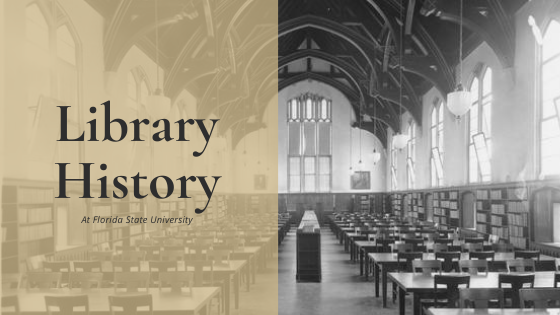The history of the Libraries at Florida State University traces back over 100 years to our beginnings as the West Florida Seminary. In the 1880s, students had access to both a reference library, housed in College Hall, and a more expansive “university library,” which was located off-campus. The first librarian for the university, J.A. Arbuckle, was appointed in 1897.
By 1903, University administration wanted the library to be “the center of college life.” New librarian Mary A. Apthorpe was appointed, and critical changes began transforming the library under her lead. The library offerings were expanded and items began being catalogued according to the Dewey Decimal System.
In 1911 the new Main Building, which is now Westcott, was completed and the library was moved. The library saw extensive growth and four different librarians during its time in the Main Building between 1911 and 1924. According to the 1914-15 course catalog, the library held over 8,500 volumes and was circulating over 600 books a month. By 1923, the library held over 16,000 volumes.
As library holdings and services continued to grow, the university recognized the need for a dedicated library building. Work began on the new space, that is now Dodd Hall, in 1924. This building served as the library for Florida State College for Women and then for Florida State University until Strozier Library was built in 1956.

The new library opened to students towards the end of 1924, and Louise Richardson was hired as the university librarian, a role she would hold until 1953. Along with being the librarian, Richardson also created curriculum for and taught the first library science courses offered by Florida State College for Women. In 1926 “Library Science” became its own instruction area, composed of two classes: Library Methods and Advanced Library Methods. In 1929, Etta Lane Matthews was hired as the first professor of Library Science.

By June 1930, the Department of Library Science was officially established and had nine faculty and seven courses. The department had also received American Library Association accreditation to properly qualify students as librarians.

As the university continued to expand their course offerings and enrollment steadily rose, the Department of Library Science was restructured in 1946 to offer a major in Library Science. In 1947, the department was renamed to the School of Library Training and Service and was established as a professional school offering a master’s degree. This was Florida’s first nationally accredited professional school for the training of librarians.

The new library building, now known as Strozier, opened in 1956. Between 1956 and 1958, major reorganization and expansion took place within the library. The Department of Special Collections was created during these years with the goal to “preserve and make available to scholars rare books and historical documents of Florida”.

This excerpt from the 1954-58 President’s Report describes some of the amenities offered by the new library. It also makes clear that from the opening of the new library, university officials recognized a need for even more space. The addition mentioned in the last sentence of the excerpt became a reality in 1967, when the library was expanded to include a 5-story annex.
In the next installments of Library History at FSU, we’ll explore how the Department of Special Collections transformed and grew after its inception in 1956. We’ll also trace the next steps for the Department of Library Training and Service, or “The Library School” as it was referenced in the President’s Report, after 1947 and how it became the online degree program it is today.

